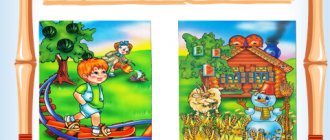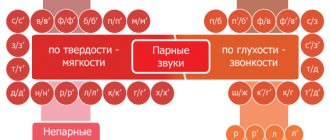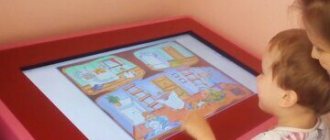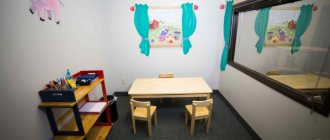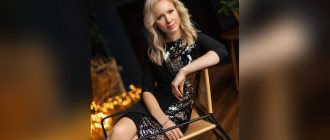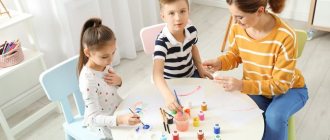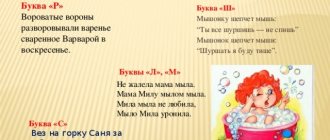Speech therapy games
The causes of impaired sound pronunciation may be:
1. Defects in the structure of the articulatory apparatus.
Material from the site
2. Insufficient formation of articulatory movements.
- Disadvantages in the development of phonemic hearing.
Deficiencies in sound pronunciation aggravate the child’s emotional and mental state, preventing him from developing and communicating with peers. Therefore, it is necessary to begin work to eliminate existing speech disorders as early as possible. Successful formation of correct sound pronunciation is impossible without preliminary preparation, namely articulatory gymnastics. Articulation gymnastics is carried out by both specialists and the child’s parents.
Articulation gymnastics should be done daily. And so that this process does not get boring for the baby, a creative approach and variety are needed on the part of the adult. Before starting articulatory gymnastics, we invite you to watch “The Tale of Merry Tongues,” which will help turn a complex process into a game and an exciting journey.
A set of exercises for the sounds S, S', Z, Z', Ts.
Bite your tongue.
Smile, open your mouth slightly and bite your tongue.
Punish a naughty tongue.
Smile, open your mouth slightly, place the wide front edge of your tongue on your lower lip and “slap” it with your lips, saying “five-five-five.” (Alternate exercises No. 1 and No. 2)
"Spatula"
Smile, open your mouth slightly, place the wide front edge of your tongue on your lower lip. Hold it in this position for a count from 1 to 5-10.
Put the ball into the goal.
“Push” a wide tongue between your lips (as if you are driving a ball into a goal), blow with your tongue pressed between your lips (do not puff out your cheeks)
Brush your teeth.
Smile, show your teeth, open your mouth slightly and use the tip of your tongue to “clean” your lower teeth from the inside.
"Coil".
Smile, open your mouth. The tip of the tongue rests on the lower teeth. Roll out the wide tongue forward and move it deep into the mouth.
A set of exercises for the sounds Ш, Ж, Ш, Ш.
Punish a naughty tongue.
Smile, open your mouth slightly, place the wide front edge of your tongue on your lower lip and “slap” it with your lips, saying “five-five-five.”
"Spatula"
Smile, open your mouth slightly, place the wide front edge of your tongue on your lower lip. Hold it in this position for a count from 1 to 5-10.
Painter.
Smile, open your mouth and “paint” the hard palate with the tip of your tongue, moving your tongue back and forth.
Cup.
Smile, open your mouth wide, stick out your wide tongue and give it a “cup” shape (i.e. slightly raise the tip of the tongue)
Delicious jam.
Smile, open your mouth slightly, and lick your upper lip from top to bottom with a wide, cup-shaped tongue.
Focus.
Smile, open your mouth slightly, place the wide front edge of your tongue on your upper lip, so that its side edges are pressed and there is a small groove in the middle. Then gently blow upward onto the tip of your nose, on which lies a piece of cotton wool. Blow the cotton wool from the tip of your nose.
Fungus.
Smile, open your mouth slightly, suck your tongue to the roof of your mouth so that the hyoid ligament is stretched (“fungus stalk”). Hold in this position for 5-10 seconds.
Harmonic.
Smile, open your mouth slightly, suck your tongue to the roof of your mouth so that the hyoid ligament is stretched. Opening and closing your mouth as if stretching the bellows of an accordion.
A set of exercises for the sounds L, L.
Material from the site
Punish a naughty tongue.
Smile, open your mouth slightly, place the wide front edge of your tongue on your lower lip and “slap” it with your lips, saying “five-five-five.”
Delicious jam.
Smile, open your mouth slightly, and lick your upper lip from top to bottom with a wide, cup-shaped tongue.
Turkey.
Smile, open your mouth slightly, quickly move your tongue along your upper lip - “bl-bl-bl-bl...”
Swing.
Smile, open your mouth slightly, place the wide tip of your tongue behind your lower teeth, and then the wide tip of your tongue behind your upper teeth. Alternately change the position of the tongue.
Horse.
Smile, open your mouth and click the tip of your tongue, like a horse clicking.
The steamer is humming.
Smile, open your mouth and tensely say a long “y-y-y...”
A set of exercises for the sounds R, Rb.
Punish a naughty tongue.
Smile, open your mouth slightly, place the wide front edge of your tongue on your lower lip and “slap” it with your lips, saying “five-five-five.”
Brush your teeth.
Smile, show your teeth, open your mouth slightly and use the tip of your tongue to “clean” your lower teeth from the inside.
Painter.
Smile, open your mouth and “paint” the hard palate with the tip of your tongue, moving your tongue back and forth.
Horse.
Smile, open your mouth and click the tip of your tongue, like a horse clicking.
Delicious jam.
Smile, open your mouth slightly, and lick your upper lip from top to bottom with a wide, cup-shaped tongue.
Turkey.
Material from the site
Smile, open your mouth slightly, quickly move your tongue along your upper lip - “bl-bl-bl-bl...”
Drummers.
Smile, open your mouth and tap the tip of your tongue behind your upper teeth, repeating clearly and loudly: “d-d-d-d-d-d”, gradually speeding up the pace.
We wish you success!
The Tale of the Happy Tongue: speech therapy project
Kutuzova V.V. The Tale of the Cheerful Tongue: a speech therapy project // Owl. 2021. N1 (19). URL: https://kssovushka.ru/zhurnal/19/ (access date: 11/19/2021).
Order No. 583397
APPENDIX: Appendix to the article
Modern speech therapy is in a constant active search for ways to improve and optimize the process of learning and development of children at different age stages and in various educational conditions that are typical for children with speech disorders.
Experience and modern research show that the pedagogical process can only increase the capabilities and quality of development of a child with speech underdevelopment to the extent that the teacher knows how to competently manage it. Success is determined by the methods and techniques of a student’s education.
The use, along with traditional ones, of innovative pedagogical technologies opens up new opportunities for the education and training of preschoolers with speech impairments, and the project method has become one of the most effective today.
It gives the child the opportunity to experiment, synthesize acquired knowledge, develop creativity and communication skills, thereby preparing him for successful learning at school. The knowledge and skills that a child acquires in the process of practical activity are acquired faster, easier and give better results; Complex and sometimes uninteresting speech therapy exercises become an exciting activity for the child.
By solving various cognitive and practical problems during the design process together with adults and peers, children with speech underdevelopment motivatedly enrich and activate their vocabulary, learn to speak publicly, and communicate adequately with others.
Many years of experience in speech therapy work have made it possible to identify some difficulties and contradictions that may arise in the process of implementing this issue.
Firstly, there is a steady trend towards an increase in the number of children with speech disorders.
Secondly, in order to increase children’s interest in speech therapy classes, we need a variety of creative tasks and new approaches to correctional work.
Thirdly, the child’s weak motivation for cognitive activity, the lack of full speech activity on the one hand, and the low level of interest and competence of parents in matters of children’s speech development.
Fourthly, the degree of development of the problem. In modern literature, more and more articles and publications are appearing that in one way or another touch on the topic of using the project method in working with preschoolers. But the area of application of this method in speech therapy practice remains poorly developed.
The goal is to increase the potential for full speech development of preschool children.
objectives :
Educational:
- develop speech activity;
- develop fantasy and imagination.
Educational:
- create a New Year's mood, a desire to create and bring joy to others;
- make children and parents want to participate in the project;
- involve parents as active participants in preparation for the project.
Educational:
- to form ideas about the organs of speech, their importance for correct sound pronunciation;
- formulate the concept of “Articulation”, highlight the characteristic features of the correct pronunciation of sounds;
- create conditions for children to become acquainted with the organs of articulation.
Corrective:
- develop subtle differentiated movements of the articulatory apparatus using non-traditional complexes.
Expected result:
- Using the project method in correctional work will contribute to the successful development of children's communicative and creative abilities.
- Increasing the psychological and pedagogical competence of teachers and parents in matters of children's speech development.
- Increasing parents' interest not only in the results, but also in the process of correctional and educational work itself.
Type of project: informational, practice-oriented, collective
Project type: short-term
Project participants: children with speech disorders, speech therapist, educators, parents.
Problem situation: a project in speech therapy work with preschool children will allow pupils to quickly, easily and more firmly “appropriate” knowledge and skills that are acquired in the process of practical activities, will increase the child’s motivation and the interest of parents in the speech development of their children.
Project products:
- homemade book “Tales of the Merry Tongue.”
Integration of educational areas: cognitive development, speech development, social and communicative development, artistic and aesthetic development, physical development.
Integration of children's activities: play, cognitive-research, motor, productive, communicative, reading (perception of fiction).
Subject-spatial development environment: kindergarten territory; in the group: visual aids.
Facilities and equipment:
Technical: laptop, projector.
Methodological: visual aids (articulation profile), illustrations for articulation exercises, a selection of fairy tales about the “Merry Tongue”.
Organizational: tables, oilcloths, paper, wax crayons, watercolors, gouache, brushes. Stages of the project “The Tale of the Merry Tongue” for children 5-7 years old with speech impairment.
| Project stages | Activities of the teacher | Children's activities |
| Stage 1. Search. | Creating conditions for children and parents to enter into a problematic situation. Determining the interest and level of knowledge of children on the topic of the project. Formation of a data bank on the level of parental competence in matters of the designated topic. | Accept the task. |
| Stage 2. Analytical. | Collection of information: — selection of software and methodological support for project implementation; — studying the experience of innovative teachers on the project topic; — replenishment of the subject-development environment; — involving parents in working on the project; — a selection of consultations on the topic of the project. | They plan with the teacher what they will do together for this: draw, glue, learn poems, songs, dances, negotiate with parents about joint work, bring additional material from home. |
| Stage 3. Practical. | Design of current work on project activities: see long-term plan (appendix). - conduct a drawing lesson; — learn sets of articulation exercises; - come up with a fairy tale about the Cheerful Tongue; — create conditions for the practical application of acquired knowledge. | Draw a funny tongue; Learn articulation exercises; They come up with a fairy tale about the Merry Tongue |
| Stage 4. Presentation. | Presentation of a collective homemade book “Tales of the Merry Tongue” Practical application of project products in morning corrective gymnast | Exhibition of collective homemade books "Tales of the Merry Tongue" |
Long-term plan for the project “The Tale of the Merry Tongue” for children 5-7 years old studying at the preschool educational institution’s speech center
| Days of the week | Joint activities of adults and children, taking into account the integration of educational areas. | Organization of a developmental environment for children’s independent activities. | Interaction with parents. | ||
| Joint activities between adults and children. | Individual activities with children. | Educational activities in special moments. | |||
| Monday 07.10.19 | Getting to know the organs of articulation | “Explain to your comrade the correct location of the organs of articulation...” | Guessing riddles about teeth, lips, tongue | Prepare a set of illustrations | Informing parents about the tasks of a speech therapist in a preschool educational institution. |
| Tuesday 08.10.19 | Conversation “Articulatory patterns of sounds” | Using gaming techniques of articulation analysis in individual lessons for correcting sound pronunciation | Practical application in morning exercise | Add to the group an album with illustrations of articulation exercises | Reminders “Structure of the articulatory apparatus” |
| Wednesday 09.10.19 | Learning poems for exercises. | individual learning of complexes of articulation exercises | Drawing a picture “Funny tongue” | Design of an exhibition of drawings | Help parents draw pictures. |
| Thursday 10.10.19 | Collective invention of the fairy tale about the Merry Tongue | Do exercises using bright illustrations | Determining the place of articulatory gymnastics in group mode | Individual demonstration of performing exercises aimed at developing the articulatory structure of a specific group of sounds. | |
| Friday 11.10.19 | Reading the fairy tale about the “Jolly Tongue” | Didactic game “Pick a picture” | Presentation of a collective homemade book “Tales of the Merry Tongue” | Repetition of an invented fairy tale | |
Literature:
- Babina E.S. Partnership between preschool educational institutions and families in speech therapy work // Speech therapist. 2005. No. 5.
- Budennaya T.V. Speech therapy gymnastics. St. Petersburg: Detstvo-Press, 1999. 64 p.
- Buyko V. Miracle teacher. Ekaterinburg: Litur, 2006.
- Veraksa N.E., Veraksa A.N. Project activities for preschoolers. M., 2010.
- Evdokimova E.S. Design technology in preschool educational institutions. M.: Sfera, 2005.
- Kiseleva L.S. project method in the activities of a preschool institution. M.: Arti, 2005.
- Konovalenko S.V., Kremenetskaya M.I. Development of the psycho-physiological basis of speech in preschool children with developmental disorders. St. Petersburg: Childhood-Press, 2012. 112 p.
- Krupenchuk O.I. Poems for speech development. St. Petersburg: Litera, 2004. 64 p.
- Mironova S.A. Speech development of preschool children in speech therapy classes. M. 2007.
- Nishcheva N.V. Fun articulation gymnastics. St. Petersburg: Detstvo-Press, 2021. 32 p.
- Repina Z.A., Buyko V.I. Speech therapy lessons. Ekaterinburg: Litur, 1999. 208 p.
- Fadeeva Yu.A., Zhilina I.I. Educational projects in a group for children with special needs. M., 2012.
